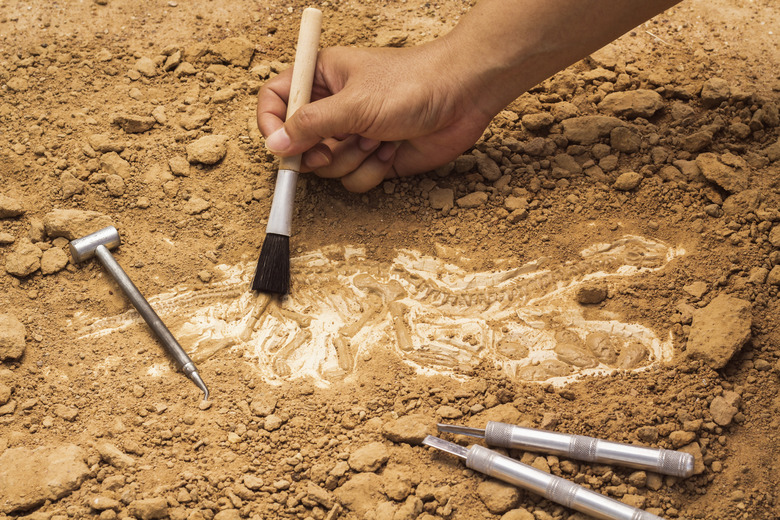The Rock Most Likely To Contain Fossils
Fossils, the preserved remains of animal and plant life, are mostly found embedded in sedimentary rocks. Of the sedimentary rocks, most fossils occur in shale, limestone and sandstone. Earth contains three types of rocks: metamorphic, igneous and sedimentary. With rare exceptions, metamorphic and igneous rocks undergo too much heat and pressure to preserve fossils. So most fossils are found in sedimentary rocks, where gentler pressure and lower temperature allows preservation of past life-forms. Fossils become a part of sedimentary rocks when sediments such as mud, sand, shells and pebbles cover plant and animal organisms and preserve their characteristics through time.
Finest Fossils
Finest Fossils
Mud forms when larger rocks erode into tiny, usually microscopic, particles. These particles settle in the calm waters of lakes, swamps and the ocean, covering creatures that live there. Mud and clay combine with minerals and other particles over time to harden into shale. The hard parts of the creatures covered with mud undergo preservation as fossils when consolidated with other materials inside the shale. Shale splits easily into layers to reveal any fossils inside. Fossils inside shale often include brachiopods, fossilized plants, algae, crustaceans and arthropods trapped in the hardened mud. The very small mud and clay particles allow small details of organisms to be preserved, like the rare fossils of soft-bodied organisms found in the Burgess Shale.
Ecosystems in Limestone
Ecosystems in Limestone
Limestone forms when calcite from the water crystallizes or when fragments from coral and shells cement together. Limestone often contains fossils of shelled sea creatures. Entire reef formations and communities of organisms are found preserved in limestone. The types of fossils found in limestone include:
- coral
- algae
- clams
- brachiopods
- bryozoa
- crinoids
Most limestone forms in shallow tropical or subtropical seas. In some cases, fossils make up the entire structure of limestone.
Buried in Sand
Buried in Sand
Cemented together grains of sand become sandstone. Since sandstone is a coarser material than shale or limestone, fossils found in them do not usually show as many details as fossils in shale and limestone. Sandstone rarely contains delicate fossils. Sandstone forms in a wide range of environments, including beaches, oceans, sand bars, dunes, rivers, deltas, deserts and flood plains. Sandstone contains fossils of creatures such as trilobites, brachiopods, crustaceans, bryozoans and plants. Remains of land animals like mastodons and dinosaurs are much more likely to be found in sandstone.
Conglomerate and Breccia
Conglomerate and Breccia
Conglomerate rocks form from combinations of large and small rounded pebbles, often containing quartz, cemented together over time. Breccia forms from angular rocks of various sizes, also cemented over time. They form faster than shale, limestone and sandstone. Conglomerates form where rocks have been broken and then tumbled until smooth. Breccias form when the broken fragments remain close to their source. In both cases, their large particles are not as likely to incorporate fossils. Conglomerate and breccia rocks do provide fossils periodically, however, in the pebbles that make up the rocks. Some fossils found in conglomerate and breccia rocks include sponges, brachiopods and gastropods.
Incredibly Rare, But...
Incredibly Rare, But...
Fossils rarely occur in metamorphic or igneous rocks. The heat and pressure required to change, or metamorphose, rocks usually destroys any fossils. However, special circumstances do happen. For example, fossilized shells and bacteria have been found in marble, which is metamorphosed limestone. The initial heat of igneous rocks would seem an impossible environment for fossil formation. But when ash from volcanic eruptions buries the surrounding area, the ash sometimes encapsulates organisms. Fossils of trees and shelled organisms like brachiopods sometimes occur in ash layers.
Cite This Article
MLA
Whitehead, Cathryn. "The Rock Most Likely To Contain Fossils" sciencing.com, https://www.sciencing.com/rock-likely-contain-fossils-8117908/. 23 April 2018.
APA
Whitehead, Cathryn. (2018, April 23). The Rock Most Likely To Contain Fossils. sciencing.com. Retrieved from https://www.sciencing.com/rock-likely-contain-fossils-8117908/
Chicago
Whitehead, Cathryn. The Rock Most Likely To Contain Fossils last modified March 24, 2022. https://www.sciencing.com/rock-likely-contain-fossils-8117908/
